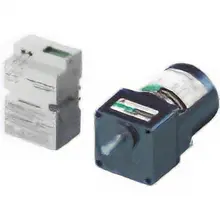What Motor Should be Used for the Winding Mechanism?


-

I'm stumped. A motor for winding up…
-

What is it, Vex? Did you get a call from a customer?
-

Ms. Ori, you've come just at the right time. A customer asked me to introduce a motor for the mechanism that winds the film in their in-house equipment, but I have no idea what kind of motor to introduce.
-

I see. It's certainly difficult for the first time because it requires characteristics that other mechanism doesn't have. Let's start by looking at a simple model to sort out the elements necessary for winding.

-

The customer said, "Constant feed speed, constant tension winding." Why does the tension have to be constant?
-

You want the tension to the material to be tight so it doesn't sag and want to roll nicely. However, if the tension is too strong, the material will shrink or break, and if it is too weak, it will wrinkle, so it is necessary to always wind with a constant and proper tension from start to finish.
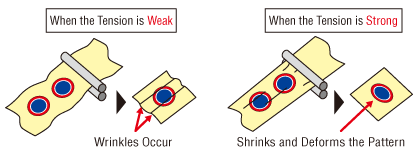
-

I see. That's what you mean.
-

So, in order to maintain a constant tension, you need a "proper brake force" while winding. By doing this, the film can be wound taut. This is the basic even if the equipment is different.
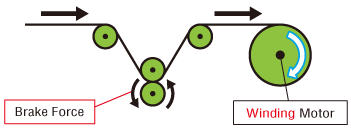
-

The key point is how to select a winding motor and brake that can achieve "constant tension." I got it! But I feel like it could be done with a constant speed motor if it's just winding up…
-

You have to keep the film tension and feed speed constant. I wonder if this is possible. Before deciding the motor types, let's consider the characteristics required to the motor. The following figure shows the model used in the previous descriptions with the actual film added.

-

So at the beginning of the winding process, all film is on the left roll.
-

The next figure shows the process to the end of the roll.
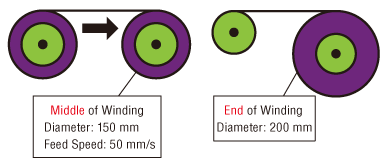
-

This figure shows that as you wind the roll, the diameter of the roll on the right gets larger and larger, and at the end of the roll, it doubles in size. I guess the film feed speed is constant at 50 mm/s.
-

That’s right. Now, calculate the rotation speed of the motor at the beginning of winding.
-

All of a sudden!? Well, pi is 3.14...
-

I hope you can calculate this quickly.
Calculate by dividing the feed speed with the (diameter multiplied by the circumference) and multiply by 60, which comes out to 9.55 r/min.
By the way, the torque at this time is 1.0 N·m, multiplied by the force and the rotation radius.
Use the same method to calculate the middle and end of the roll. -

...... finished. The table below shows the results.

-

That's right. The important thing in this table is that as you go from the beginning to the end of winding, the "rotation speed slows down" and the "torque increases." So the required characteristics of the winding motor would be shown in the figure below.
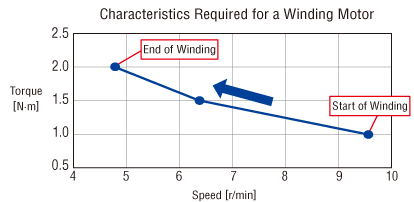
-

Well, I understand the characteristics, but can we talk about what kind of motor it is?
-

This time it's a special edition with a long article!
Next, I'll explain the types of motor. Keep your focus "on high tension" and follow me. -

Yes sir!
So, Ms. Ori, based on the characteristics mentioned earlier... what kind of motor should I choose for the winding axis? The fact that you need to slow down the rotation speed and increase the torque to match the diameter means that this can't be done with the constant speed motors. -

That's right. In fact, there is a motor that has the perfect characteristics to make winding easier. Do you know what a "torque motor" is?
-

Uh...just the name... Please tell me the details! What makes it so suitable?
-

Look at the "speed - torque characteristics" below. Regarding the characteristic of torque motor, is there anything you notice?
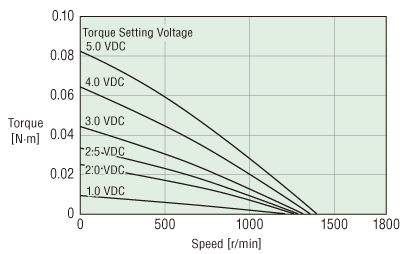
-

Let's see, the torque increases as the rotation speed decreases. It’s similar to the characteristics needed for a take-up motor we saw at the end of the first half!
-

You've got a good point. Yes, a torque motor has characteristics similar to those required for a winding motor. If the required characteristics match the "speed - torque characteristics," it's possible to wind at a constant feed speed and constant tension.
-

I see! That is perfect for a winding motor. Why are there several torque characteristic lines drawn in the diagram?
-

The torque motor can adjust the torque. This figure shows the torque motor and power controller package TM Series, which can be easily adjusted to increase or decrease the torque with the controller's potentiometer.
-

So you don't need any difficult controls! I have a good understanding of the winding axis now. What should I recommend for the brakes? I guess it doesn't matter because it's not a motor at the first place...
-

Actually, you can use torque motors for braking applications as well. You can use it as a brake by rotating it in the opposite direction of the winding direction.
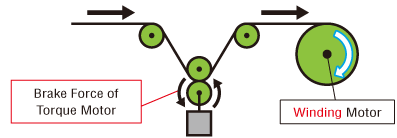
-

Wow, torque motor is amazing... But wait a minute. I think a constant speed motor would be fine for this usage.
-

Actually, here's another reason why it has to be a torque motor. If other motors used as a brake, they may get hot or have a protective function that stops them.
-

I didn’t realize! Torque motors can be used in so many ways. What kind of characteristics does it have when you use as a brake?
-

Let’s see. You also need to know the characteristics as well.
The right figure shows the characteristics of a torque motor as a brake.Let’s see. You also need to know the characteristics as well.
The figure below shows the characteristics of a torque motor as a brake. -

Even if the rotation speed increases, the brake force doesn't change that much.
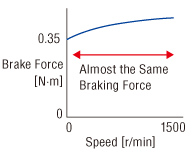
-

That's right. One of the nice characteristics of torque motors is that there is no significant difference in brake force as the rotation speed changes.
-

What are the benefits to the customer?
-

Depending on the equipment, the film feed speed may be changed or the film may be stopped mid-way for some processing. So it's useful if the brake force doesn't change depending on the feed speed. And you can adjust the brake force just as you use it like a winding motor.
-

I've got it now! If winding mechanisms comes up, I'll introduce the torque motor first. What other motors are used?
-

The BXII Series of brushless motors are also commonly used as motors for winding mechanisms. This series has a function called torque limiting, which means you can use it just like a torque motor. You can also write the torque limiting value digitally into the driver, so you don't have to do any fine adjustments. It's a good idea if you're using multiple motors.
-

So you can use brushless motors in addition to torque motors. Thank you! I think I can suggest the perfect motor for the customer!
